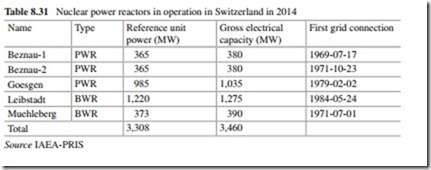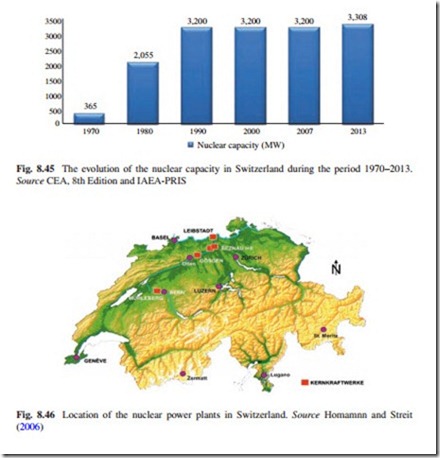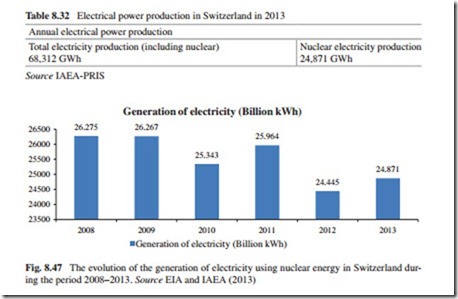Switzerland
Switzerland has a highly developed industrialized economy and one of the highest standards of living in the world. The main energy resources available are essentially hydropower. For this reason, the use of nuclear energy for electricity genera- tion has been an essential element of the energy balance of the country since 1969, when the first nuclear power reactor entered in operation.
However, after the Fukushima Daiichi nuclear accident, the public opinion in Switzerland changed drastically and started asking the government to adopt a new energy policy, excluding the use of nuclear energy for the generation of electricity.
In October 2014, the first package of measures of Switzerland’s proposed new energy policy—including the phase-out of the use of nuclear energy—is ready to be debated by the parliament. Switzerland’s federal government has already decided to phase-out the five nuclear power reactors, which generate 40 % of the country’s electricity, by not replacing them with new nuclear capacity at the end of their anticipated working lives. The move would effectively see all of Switzerland’s nuclear power plants shutdown by 2035. The decision came in response to the March 2011 accident at Fukushima Daiichi nuclear power plant, despite a referendum the previous month that supported the replacement of the oldest nuclear power reactors.
The environment, spatial planning, and energy committee of the National Council—the Lower House of the Swiss parliament (Federal Assembly)—announced on 28 October that after more than a year of intensive preliminary discussion it had completed its review of the draft decree. The cross-party committee voted 14–9 in favor of the draft decree. The first part of the new energy policy is now set to be debated by the Lower House during the next parliamentary session.
The committee also voted on the recommendations of a popular initiative sub- mitted by the Green Party for a partial revision of the federal constitution on the phase-out of nuclear energy, which would see the country’s last reactor shut in 2029. However, the committee rejected this initiative, as well as a proposal to link it to the draft decree. Under this provision, the new energy policy can only enter into force, if the popular initiative is withdrawn or rejected.
The draft decree proposes that nuclear power plant operators can submit a plan for extending the long-term operation of their reactors for a further ten years. The committee decided to keep this proposal, despite some members calling for the operating lives of reactors to be limited to 50 or 60 years. A minority of committee mem- bers wanted the option for reactor life extensions to be removed altogether. Given operating life spans of 50 years, the first Swiss reactor to shut could be Beznau 1 in 2019, followed by Beznau 2 in 2021. Taken together, these smaller units would remove only 730 MW from supply. Another 372 MW would be lost with the shut- down of Mühleberg around 2022. The largest units are Gösgen with 985 MW and Leibstadt with 1,165 MW, which would likely close in 2029 and 2034, respectively.
Switzerland has five nuclear power reactors in operation in 2014 with a power capacity of 3,308 MW (see Table 8.31).
The evolution of the nuclear capacity in the period 1970–2013 in Switzerland is shown in Fig. 8.45. According to this figure, the nuclear capacity in the country increased 9-fold. However, since 1990, the nuclear capacity has increased only 3.3 %.
The location of the nuclear power plants operating in Switzerland is shown in Fig. 8.46.
It is important to highlight that all Swiss nuclear power plants have upgraded their power capacity. At the end of 2002, the nominal net powers were 365 MW for Beznau, 355 MW for Mühleberg, 970 MW for Gösgen, and 1,165 MWe for Leibstadt nuclear power plants (Switzerland nuclear power program 2003). In 2014, the new capacities of the current nuclear power reactors operating in the country are shown in Table 8.31. As can be seen in this table, all units increased their capacity in 2014..
The Energy Policy and the Nuclear Law in Switzerland
The current Swiss energy policy has been focused on generating domestic electric power without burning fossil fuels for already four decades. In 2007, around 57 % of the electricity was generated in hydroelectric power plants, which is possible due to the country’s favorable topography; the remaining 43 % was produced by the country’s five nuclear power plants.
In 2003, a nuclear law was adopted by the Swiss parliament with the purpose of implementing the country’s energy policy. The Nuclear Energy Act of 2003, valid since the first of February 2005, incorporates some important paragraphs for the future use of nuclear energy for the generation of electricity in the country. These paragraphs are the following:
• From mid-2006 to 2016, it is forbidden to reprocess spent nuclear fuel elements by a moratorium;
• All nuclear power plants got an unlimited license;
• To get a license for a new nuclear power plant, a verification of documentation of feasibility of final waste disposal is needed;
• To get a license for a new nuclear power plant a facultative referendum is possible;
• Today’s power plants have to verify the final waste disposal till 2015 (Homamnn and Streit 2006).
One of the important components of the new energy policy adopted by the Swiss government is the use of renewables and gas-fired power plants for the generation of electricity and an increase of energy efficiency, in addition to the use of nuclear energy and hydro for the same purpose. It is important to highlight that, accord- ing to WANO sources, without new investment in the energy sector in the coming years a 20 billion kWh per year shortfall is predicted by 2020, representing a 25 % of the future demand. This is due to phasing out of an electricity import arrange- ment from France, closure of the small Beznau and Muhleberg nuclear power reactors, and the closure of a 355 MWe hydropower plant, effectively removing 2,400 MWe (Nuclear Power in Switzerland 2008).
However, this situation could be worse if all nuclear power reactors currently in operation in the country are shutdown after reaching their current operational life- time, and no other energy sources are used for the generation of electricity.
On the other hand, it is important to highlight the following. Initially, the costs of the closing of the Swiss nuclear power plants were included in the costs of each unit, but a different system that extends the obligations for a five-year period after the definitive stop of the units was adopted by the government. Later on the cost of the closure and the cost of the waste management were added.
According to a study carried out in 2006 and presented recently by the Swiss Nuclear Forum, the total costs associated with the closure of the five Swiss nuclear power reactors currently in operation would be around US$1,269 million, included the costs of the five years period after the stop of the operation of all units, the transfer of the spent nuclear fuel to the pools located in the nuclear power plant site, the supervision of the cooling of the reactor, the cost of the radiological pro- tection, and of the personnel in charge of the closure of the nuclear power plant, among others. In addition, it is important to know that the costs of the long-term closing should be paid annually by the electric companies to a national fund estab- lished in 1984. The costs of the waste management will be covered by another fund established in 2001. The study estimates in US$11,710 million the total costs of closing all nuclear power reactors and the waste management.
Electricity Generation Using Nuclear Energy
The electricity consumption in Switzerland has grown at about 2 % per year since 1980. In 2004, electricity production was 65 billion kWh, matching demand. In
2006, the use of nuclear energy for electricity generation contributed 37.4 % of Swiss total electricity generation (26.4 billion kWh). In 2007, the production of electricity using nuclear energy was 26.3 billion of kWh, representing 43 % of the total electricity production in the country (around 61 TWh). In 2013, the total generation of electricity and the role played by nuclear energy can be seen in Table 8.32.
The generation of electricity using nuclear energy in Switzerland in 2013 represented 36.41 % of the total; this represents a decrease of 0.99 % with respect to 2006.
The evolution of the generation of electricity using nuclear energy in Switzerland during the period 2008–2013 is included in Fig. 8.47.
According to Fig. 8.47, the generation of electricity using nuclear energy in Switzerland during the period 2008–2013 decreased 5.4 %. It is expected, according to the draft of the new energy law under discussion in the Swiss parliament, that the generation of electricity using nuclear energy in Switzerland will continue decreasing during the coming years. All nuclear power reactors will be shutdown before 2035.
The Public Opinion
According to Morales Pedraza (2012), the nuclear controversy began in Switzerland in 1969 with the first signs of local opposition to the construction of a nuclear power plant at Kaiseraugst, near Basel. For 20 years, the Kaiseraugst project was the center of the nuclear controversy. The controversy involved site permit, local referenda, legal battles, site occupation by opponents in 1975, parliamentary vote in favor of construction in 1985 and, finally, the parliamentary decision in 1989 to finish the project definitively.
The Chernobyl nuclear accident had drastically affected the political climate in Switzerland with respect to the use of nuclear energy for electricity generation. As a consequence of this nuclear accident and due to a strong public opposition, the proposal to construct a nuclear power plant in Graben was also canceled.
The controversy over the construction of new nuclear power plants led to several antinuclear initiatives at the federal level. These initiatives were the following:
• An attempt to prohibit the operation of all nuclear power plants, as well as the prohibition to construct new ones was rejected by 51.2 % of the voters in a referendum carried out in February 1979;
• An attempt to prohibit the construction of new nuclear power plants, leaving
untouched all nuclear power plants currently in operation was also rejected;
• Two initiatives differing only in the treatment to be applied to Leibstadt, then under construction, were rejected by 55 % of the voters in a referendum carried out in September 1984;
• A proposal to phase-out all nuclear power plants was rejected by 52.9 % of the voters in a referendum carried out in September 1990;
• A proposal to 10-year moratorium was accepted by 54.6 % of the voters in a referendum carried out in September 1990;
• In 1999, two new initiatives were presented; one to ban the construction of new nuclear power plants until 2010 and the second to close all nuclear power plants over a 30-year life span rejected in two referendums carried out in May 2003 by 58.4 % and by 66.3 % of the voters, respectively.
The Fukushima Daiichi nuclear accident increased the opposition of the public opinion to the use of nuclear energy for the generation of electricity and forced the government to draft a new energy law excluding the use of this type of energy source for electricity generation in the future. The new draft foresees the closure of all nuclear power reactors in operation in the country after the termination of their operational life.
Looking Forward
After the rejection of all initiatives to abandon the use of nuclear energy for electricity generation in the country in 2006, the Swiss authorities started looking for partners to build a large nuclear power plant using proven technology and probably at an existing nuclear plant site, preferable Beznau, where another two nuclear power reactors are currently operating.
In 2007, a joint venture was formed for the construction of two identical nuclear power reactors with a power capacity of 1,600 MWe each at Beznau and Mühleberg sites. It is important to highlight that in the case of the Mühleberg nuclear power plant personalities of the economic and industrial world of the cantons of Berne, Friburgo, Swears, and Neuchâtel created, on May 2009, the “Forum Pro Mühleberg” to support the continuation of the operation of the nuclear power plant in Mühleberg, because the electricity produced by the plant is indis- pensable for the region. The closure of the Mühleberg nuclear power plant will stop the development of the whole region bearing in mind the growing increase of the electricity consumption foresees in the coming years, and the popula- tion’s favorable opinion toward the continuation of the operation of the nuclear power plant. The population in Mühleberg is supporting the construction of a new nuclear power plant in this site in the future.
Early in 2008, an announcement was made for a license to build a new nuclear power reactor at Gösgen with the purpose of satisfying, at least partially, a foresee shortage of generation of electricity by 2020. In the opinion of some experts, this foresees shortage can only be partly met by the use of nuclear energy and the rest by the use of conventional technologies and imports. All these initiatives were canceled.
The costs of decommissioning the existing nuclear power plants are estimated at CHF 1.5 billion. Switzerland’s decision not to build any new nuclear-generating capacity will cost the country some CHF 30 billion up to 2050, according to the country’s Department of the Environment, Transport, Energy, and Communications.
Summing up can be stated that the use of nuclear energy for the production of electricity will not be part of any future energy plan to be adopted by the Swiss government, not only to satisfy any foresee increment in the electricity demand in the future, but to fulfill the commitments assumed by the Swiss government regarding the reduction of the emission of CO2 to the atmosphere within the Kyoto Protocol. The intention of the government and the parliament is to use nuclear energy until 2035 and starts the closure of all nuclear power reactors in operation in the country as soon as possible. The final aim of the new energy law under consideration was to exclude the use of nuclear energy for the generation of electricity in the future.


